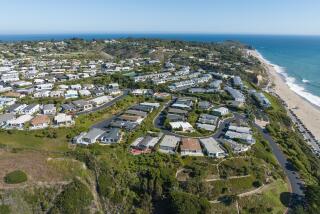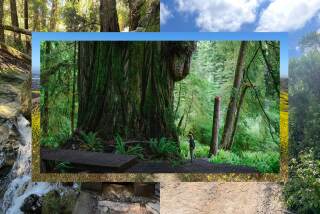Rain, rain, come this way
When Malibu’s new central park opens Saturday, visitors will see sculptures of a giant king snake and burrowing owl covered in jazzy mosaic tiles. And those who stroll the park’s decomposed granite pathways will observe hillocks, 500 freshly planted trees and cyan-colored patches of mulch and seeds that should grow to resemble coastal prairie.
Less obvious, however, will be the park’s reason for being: reducing water pollution.
Buried beneath visitors’ feet is a sophisticated network of pipes and filters engineered to remove bacteria, metals and trash from the stormwater runoff that has long contaminated Malibu Creek, Malibu Lagoon and the point break at Surfrider Beach.
The $38-million Malibu Legacy Park is considered to be the centerpiece of the city’s commitment to clean water, a commitment that coastal activists say is welcome if long overdue.
The Civic Center site had been targeted for development by Malibu Bay Co., owned by media magnate and part-time Malibu resident A. Jerrold Perenchio. After several proposals went nowhere, the city raised $25 million to buy the property, known locally as the Chili Cook-off site for an annual Labor Day weekend festival held there for many years.
The city then had to amass $13 million more to build Legacy Park and the stormwater-treatment facility. Among high-profile contributors to the project were Rita Wilson and Tom Hanks, Don Henley, Rob and Michele Reiner, the Eli and Edythe Broad Foundation and the Marilyn and Jeffrey Katzenberg Family Foundation. Additional funds came from Santa Monica College bond money, Los Angeles County and the State Water Resources Control Board, with which Malibu recently wrestled over the issue of septic systems.
Donors’ names adorn tiles and wooden benches placed throughout the site. The park is bounded by Pacific Coast Highway, Webb Way, Civic Center Way and the shopping areas along Cross Creek Road.
After native plants grow in, the area will feature a variety of habitats: coastal prairie, coastal bluff, woodland and riparian. The landscape is designed to attract coyotes, California quails, red-tailed hawks, Western toads and other critters that have abandoned once-wild lands. Vernal pools, a creek and a stormwater detention basin will feature water only during rainy times.
Park trees include such native varieties as California live oak, sycamore and cottonwood, while man-made hills provide visual interest and muffle the noise from vehicles roaring by on PCH. Scattered throughout are outdoor classrooms where students will hear presentations from docents.
Even before runoff from the Malibu Creek watershed enters the park, screening equipment will capture food containers, paper cups and other detritus, said Bob Brager, Malibu’s public works director. The water will then flow through a bio-filtering creek to a detention basin where sediment can settle. Next, gravity will draw the water to a treatment facility on the north side of Civic Center Way, where it will be filtered and disinfected with ozone. Finally, it will be pumped back to the park and used for irrigation.
City Manager Jim Thorsen calls the park and plant an “environmental cleaning machine,” capable of treating about 2 million gallons a day.
With the park’s limited vegetation, the eight giant mosaic sculptures of creatures are certain to grab attention. Fabricated at a plant in Redding, they were decorated by Robin Indar, a Northern California mosaic artist, and her team. (For more information and photos of the sculptures, visit Indar’s blog at https://robinindar.blogspot.com/.)
One environmental leader expressed regret that Legacy Park would not also treat wastewater, as the city had initially proposed. Studies showed the site did not lend itself to treating sewage because it contained relatively impermeable clay.
“I feel like Malibu missed an opportunity to make a really huge difference,” said Liz Crosson, executive director of Santa Monica Baykeeper, which unsuccessfully challenged the project in court. Crosson added that she fears the site could be overwhelmed in particularly rainy weather.
State water quality officials recently approved a moratorium under which Malibu must wean itself off septic systems in the Civic Center area and adjoining residential neighborhoods and build its first central sewage treatment facility.
Mark Gold, president of Heal the Bay, agreed that it was unfortunate the park could not accomplish both goals but said he sees many positives. “From an urban planning perspective, this provides Malibu with a center, which they’ve always needed,” he said. “It’s environmentally themed, has native plants and provides stormwater abatement.”
Legacy Park is at least a start, said Tracey Hanson, a Malibu resident since 1979. “It’s been such an eyesore, and it’s nice to see something beautiful,” she said. As for the stormwater, she added, “better it’s treated there than in our oceans.”
More to Read
Sign up for The Wild
We’ll help you find the best places to hike, bike and run, as well as the perfect silent spots for meditation and yoga.
You may occasionally receive promotional content from the Los Angeles Times.







